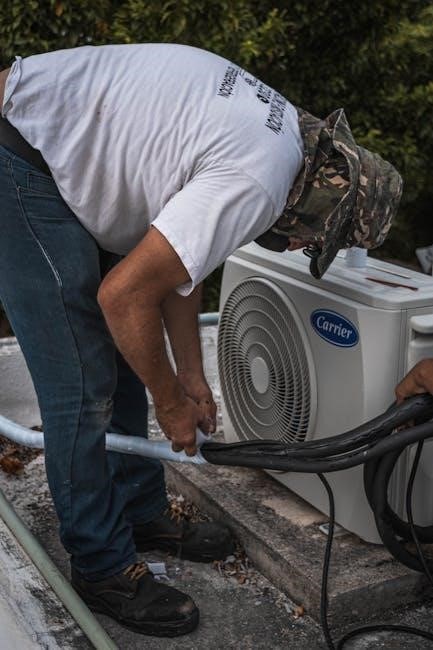carrier 30rap service manual pdf
The Carrier 30RAP Service Manual is a comprehensive guide for installation, operation, maintenance, and troubleshooting of the AquaSnap 30RAP air-cooled chiller. Designed for technicians and service personnel, it ensures safe and efficient servicing, optimizing chiller performance and compliance with industry standards.
1.1 Overview of the Carrier 30RAP Unit
The Carrier 30RAP is a high-efficiency, air-cooled chiller designed for commercial and industrial applications. It features a compact, all-in-one package with advanced components like digital scroll compressors, ensuring quiet operation and energy savings. The unit is lightweight and easy to install, making it a cost-effective solution for cooling systems. Its design incorporates environmentally friendly refrigerants and meets strict industry standards for performance and reliability. The 30RAP is part of Carrier’s AquaSnap series, known for its versatility and durability in various HVAC applications.
1.2 Importance of the Service Manual
The Carrier 30RAP Service Manual is essential for ensuring optimal performance and longevity of the unit. It provides detailed instructions for installation, operation, and maintenance, reducing the risk of equipment damage. Technicians rely on this manual to diagnose and resolve issues efficiently, minimizing downtime. Adhering to the guidelines ensures compliance with safety standards and manufacturer recommendations. Regular reference to the manual helps maintain warranty validity and prevents costly repairs. It serves as a critical resource for troubleshooting and keeping the chiller running at peak efficiency.
1.3 Target Audience for the Manual
The Carrier 30RAP Service Manual is primarily intended for qualified service technicians and HVAC professionals involved in the installation, operation, and maintenance of the AquaSnap 30RAP chiller. Facility managers and building operators will also benefit from the guidelines provided. While the manual is detailed, it is recommended that only trained personnel perform complex tasks. Basic maintenance functions, such as routine inspections, can be carried out by untrained individuals, but critical servicing requires expertise to ensure safety and efficiency. This ensures the chiller operates optimally and safely.
Safety Considerations and Precautions
The Carrier 30RAP Service Manual emphasizes safety guidelines to ensure safe handling and compliance with industry standards. Proper training and adherence to protocols are essential.
2.1 General Safety Guidelines
The Carrier 30RAP Service Manual outlines essential safety guidelines to ensure safe handling of the unit. Proper training is required for personnel to avoid risks. Always dehydrate the system before servicing to prevent contamination. Tag electrical disconnects to prevent accidental power restoration. Follow ASHRAE standards for safe practices. Adhere to all safety protocols to maintain efficiency and environmental compliance. These guidelines are crucial for protecting both personnel and equipment during maintenance tasks.
2.2 Safe Handling of Refrigerants
The Carrier 30RAP Service Manual emphasizes proper refrigerant handling to ensure safety and environmental compliance. Always wear personal protective equipment when handling refrigerants. Follow procedures outlined in Chapter 1 of the Carrier Standard Service Techniques Manual. Avoid using compressors for dehydration. Ensure proper disposal of refrigerants to prevent environmental harm. Refer to the manual for detailed instructions on refrigerant management and safety protocols. Adherence to these guidelines minimizes risks and ensures compliance with industry standards.
2.3 Electrical Safety Measures
Electrical safety is paramount when servicing the Carrier 30RAP unit. Always disconnect power before performing maintenance. Use lockout/tagout procedures to prevent accidental startups. Ensure the system is grounded properly to avoid electrical shocks. Never work on electrical components in wet conditions. Refer to the manual for specific guidelines on handling electrical parts and testing procedures. Adherence to these measures ensures technician safety and prevents equipment damage. Proper electrical safety practices are critical for efficient and secure servicing of the chiller. Always follow industry standards and the manual’s instructions.

Installation and Start-Up
The Carrier 30RAP installation requires careful site preparation and adherence to manual guidelines. Ensure proper alignment, leveling, and connection of electrical and refrigerant systems. Post-installation, follow start-up procedures to test functionality and performance, ensuring compliance with safety and operational standards. Proper installation is key to optimal chiller efficiency and longevity. Always refer to the manual for detailed step-by-step instructions and troubleshooting tips.
3.1 Pre-Installation Checks
Before installing the Carrier 30RAP chiller, conduct thorough pre-installation checks to ensure compatibility and readiness. Verify the site meets all specifications, including electrical supply, space, and ventilation requirements; Inspect the unit for damage during shipping and ensure all components are included. Check refrigerant levels and system pressure, and confirm all safety devices are functional. Review the manual for specific guidelines and refer to diagrams for proper connections. Proper preparation ensures a smooth installation process and prevents potential issues during operation. Adherence to these steps is crucial for efficient and safe chiller performance.
3.2 Step-by-Step Installation Process
Follow the Carrier 30RAP Service Manual for a systematic installation process. Begin by placing the unit on a level surface, ensuring proper clearance for airflow and maintenance access. Connect the refrigerant lines according to the diagram, ensuring tight seals to prevent leaks. Next, establish electrical connections, verifying voltage and phase alignment with the unit’s specifications. Install any optional components, such as digital scroll compressors, as outlined in the manual. Conduct a final inspection to ensure all connections are secure and the system is ready for start-up. Adhere to safety guidelines throughout the process to ensure a safe and efficient installation.
3.3 Initial Start-Up Procedures
After installation, follow the Carrier 30RAP Service Manual for initial start-up. Begin by ensuring all electrical connections are secure and the system is powered off. Verify refrigerant levels and check for leaks using approved methods. Power on the unit and monitor the control panel for error codes. Gradually test the chiller’s cooling capacity, observing temperature and pressure readings. Ensure proper airflow and verify that all components operate smoothly. Document any anomalies and address them promptly. Complete a final inspection to confirm safe and efficient operation before handing over to the user.

Operation and Service
This section covers the operation and service of the Carrier 30RAP, ensuring efficient performance through proper routine maintenance tasks and adherence to essential safety guidelines.
4.1 Understanding the Control System
The control system of the Carrier 30RAP is a sophisticated interface designed to monitor and regulate chiller operations. It features advanced digital controls that optimize performance, energy efficiency, and reliability. The system includes a user-friendly interface that allows technicians to access operational data, adjust settings, and perform diagnostic checks. The digital scroll compressor option integrates seamlessly with the control system, enabling precise temperature control and adaptability to varying load demands. Proper understanding of the control system is essential for maximizing efficiency, ensuring safe operation, and maintaining optimal performance. Trained personnel should refer to the manual for detailed instructions.
4.2 Operating the Chiller Efficiently
Operating the Carrier 30RAP chiller efficiently requires adherence to recommended guidelines in the service manual. Ensure proper load management, optimize temperature settings, and maintain consistent airflow. Regularly monitor system performance to avoid overloading, which can reduce efficiency. Utilize the digital scroll compressor option for precise capacity modulation, ensuring energy savings. Schedule periodic checks to maintain clean condenser coils and evaporators, as dirt buildup can hinder performance. Refer to the manual for detailed operational parameters and troubleshooting tips to maximize efficiency and extend equipment lifespan. Proper operation ensures reliable cooling, reduced energy consumption, and prolonged system durability. Always follow safety protocols during operation.
4.3 Routine Service and Maintenance
Routine service and maintenance are critical for ensuring optimal performance and longevity of the Carrier 30RAP chiller. Daily checks include inspecting electrical connections, refrigerant levels, and condenser cleanliness. Weekly, clean air filters and check for refrigerant leaks. Monthly, inspect and clean condenser coils, and verify proper thermostat operation. Annually, perform detailed inspections of compressors, fans, and electrical components. Always follow procedures outlined in the service manual, and ensure all tasks are performed by trained personnel to maintain safety and compliance with manufacturer recommendations. Regular maintenance prevents downtime and ensures efficient operation.

Maintenance Requirements
Regular maintenance ensures the Carrier 30RAP operates efficiently. Daily, weekly, and monthly tasks maintain performance. Annual inspections prevent issues, ensuring longevity and optimal energy efficiency.
5.1 Daily Maintenance Tasks
Daily maintenance for the Carrier 30RAP involves inspecting the air filters, checking refrigerant levels, and monitoring system pressures. Ensure all electrical connections are secure and verify that the condenser and evaporator coils are clean. Also, check the operation of fans and pumps to ensure proper airflow and fluid circulation. Log any unusual noises or vibrations, and perform a visual inspection of hoses and belts for signs of wear. These tasks help prevent issues and maintain efficiency.
5.2 Weekly and Monthly Maintenance Schedules
Weekly maintenance includes inspecting fan operation, belt tension, and refrigerant lines for leaks. Clean condenser coils to ensure proper heat transfer. Monthly tasks involve checking the evaporator coil, drain pan, and water pump operation. Inspect electrical connections and compressors for overheating. Replace air filters if necessary and verify the proper function of safety devices. Monthly maintenance also includes checking the refrigerant charge and logging system performance data. These schedules ensure optimal efficiency and prevent potential issues before they escalate.
5.3 Annual Maintenance Procedures
Annual maintenance is critical for ensuring the longevity and efficiency of the Carrier 30RAP chiller; Key tasks include checking and refilling refrigerant levels, inspecting and cleaning condenser and evaporator coils, and replacing air filters. Electrical connections should be tightened, and compressor operation must be verified. Additionally, inspect the water pump, drain lines, and safety devices for proper function. Replace worn belts and bearings as needed. Log all maintenance activities and perform a full system diagnostic to identify potential issues early. These procedures ensure optimal performance and extend the equipment’s lifespan.
Troubleshooting Common Issues
Identify and resolve common faults like error codes, coolant leaks, or sensor malfunctions. Refer to diagnostic charts and repair procedures in the Carrier 30RAP manual for solutions.
6.1 Identifying Common Faults
This section outlines common issues with the Carrier 30RAP, such as error codes, alarm conditions, or operational malfunctions. It details symptoms like high discharge pressure, low refrigerant levels, or sensor inaccuracies. By recognizing these faults early, technicians can prevent system downtime. The manual provides a troubleshooting chart to help pinpoint root causes, ensuring efficient diagnosis and repair. Always refer to the manual for specific procedures and safety guidelines when addressing these issues.
6.2 Diagnostic Techniques
Diagnosing issues with the Carrier 30RAP involves systematic checks using tools like error codes and alarm condition logs. Technicians should access the unit’s control system to review alarm history and performance data. Visual inspections of refrigerant levels, compressor operation, and fan performance are essential. Utilizing software tools like ComfortWORKS or ComfortVIEW can provide detailed insights. Always follow the manual’s troubleshooting charts to isolate faults accurately. Regular system tests ensure reliable operation and minimize downtime, guiding technicians to the root cause efficiently.
6.3 Repair and Resolution Procedures
Repairs on the Carrier 30RAP require adherence to detailed procedures outlined in the manual. Always start by identifying the root cause using error codes and alarm logs. Replace faulty components like compressors or sensors with genuine parts. Use diagnostic tools like ComfortWORKS or ComfortVIEW for precise adjustments. After repairs, perform a system test to ensure proper operation. Refer to the manual’s wiring diagrams and technical specifications for guidance. Document all actions and test results for future reference, ensuring compliance with safety protocols and manufacturer recommendations.

Technical Specifications and Data
The Carrier 30RAP features advanced technical specifications, including high-efficiency ratings, optimized cooling capacity, and compatibility with eco-friendly refrigerants. Detailed performance metrics and operational parameters are provided.
7.1 Key Technical Parameters
The Carrier 30RAP includes essential technical parameters such as cooling capacity, power consumption, and refrigerant type. These specifications ensure compatibility and optimal performance across various applications, enhancing efficiency and reliability.
7.2 Performance Ratings
The Carrier 30RAP achieves high efficiency with ratings such as EER (Energy Efficiency Ratio) and COP (Coefficient of Performance). These metrics ensure compliance with industry standards, delivering energy savings and reliable operation. Performance ratings are certified by organizations like AHRI and ASHRAE, guaranteeing adherence to quality and efficiency benchmarks. The unit’s optimized design maximizes cooling capacity while minimizing energy consumption, making it suitable for various commercial and industrial applications. Refer to the service manual for detailed performance charts and guidelines to interpret these ratings accurately for optimal system performance.
7.3 Compatibility with Building Systems
The Carrier 30RAP is designed to integrate seamlessly with various building systems, ensuring compatibility with existing infrastructure. It supports integration with Building Management Systems (BMS) and works alongside HVAC controls for centralized monitoring. The unit is compatible with standard electrical connections and communication protocols like BACnet and Modbus, enabling smooth interaction with other building systems. Its compact design allows for installation in diverse settings, from small commercial spaces to large industrial facilities. This adaptability ensures the chiller can be easily incorporated into new or retrofit projects, maintaining system harmony and performance.

Compliance and Standards
The Carrier 30RAP complies with industry standards and regulations, ensuring environmental and operational compliance. It meets ASHRAE guidelines and holds certifications for energy efficiency and safety.
8.1 Industry Standards and Regulations
The Carrier 30RAP adheres to various industry standards, including those set by ASHRAE and ANSI. Compliance ensures the unit meets energy efficiency and safety requirements, while also aligning with environmental regulations. Proper installation and operation must follow these guidelines to maintain certification and optimal performance. Referencing the service manual is crucial for understanding specific compliance measures and ensuring all regulatory standards are met during installation and servicing. This ensures the chiller operates safely and efficiently, meeting both industry and environmental expectations.
8.2 Environmental Compliance
The Carrier 30RAP is designed to meet strict environmental standards, ensuring minimal ecological impact. It utilizes eco-friendly refrigerants and energy-efficient technologies to reduce emissions and energy consumption. The unit complies with global environmental regulations, promoting sustainable operation. Proper disposal of refrigerants and materials is emphasized in the service manual to align with environmental best practices. By adhering to these guidelines, the 30RAP supports green building initiatives and helps reduce its carbon footprint, making it an environmentally responsible choice for cooling solutions.
8.3 Certifications and Approvals
The Carrier 30RAP unit is certified by reputable organizations, ensuring compliance with industry standards. It meets ASHRAE guidelines and holds certifications from UL (Underwriters Laboratories) and AHRI (Air-Conditioning, Heating, and Refrigeration Institute). These approvals confirm the unit’s safety, efficiency, and reliability. The chiller also adheres to environmental regulations, making it a compliant choice for various applications. Proper documentation and certification details are outlined in the service manual, providing users with assurance of its quality and adherence to global standards. This ensures the 30RAP operates safely and efficiently in diverse environments.

Advanced Features and Options
The Carrier 30RAP offers advanced features like digital scroll compressors for enhanced efficiency and quiet operation. Optional upgrades include energy-saving controls and remote monitoring systems, ensuring optimal performance and adaptability to various applications. These features are detailed in the service manual, providing users with tools to maximize the unit’s potential and operational flexibility.
9.1 Digital Scroll Compressor Option
The Digital Scroll Compressor in the Carrier 30RAP enhances performance by modulating capacity to match load demands, improving efficiency and reducing energy consumption. This feature ensures quieter operation and extends equipment lifespan by minimizing wear. The service manual details installation, operation, and maintenance procedures for this option, emphasizing proper setup to achieve optimal benefits. It also outlines troubleshooting steps for common issues, ensuring users can resolve problems efficiently and maintain peak performance. This makes the digital scroll compressor a valuable upgrade for modern chiller systems.
9.2 Energy Efficiency Features
The Carrier 30RAP incorporates advanced energy efficiency features designed to minimize power consumption while delivering optimal performance. These include a modular design that allows the chiller to adapt to varying load demands, reducing unnecessary energy use. The unit also utilizes smart controls to optimize cooling output and ensure efficient operation. Additionally, the chiller’s eco-friendly refrigerants and advanced heat transfer technologies contribute to lower environmental impact. These features make the 30RAP an environmentally responsible and cost-effective solution for commercial cooling needs. Proper maintenance, as outlined in the service manual, ensures these efficiency benefits are sustained.
9.4 Optional Accessories and Upgrades
The Carrier 30RAP offers a range of optional accessories and upgrades to enhance performance and customization. These include advanced control systems, remote monitoring solutions, and energy-saving technologies. Users can opt for digital scroll compressors to improve efficiency and reduce noise. Additional upgrades may involve integrating smart sensors for real-time performance tracking. Accessories like specialized filters or condenser coatings can further optimize operation in specific environments. These options allow users to tailor the chiller to their unique needs, ensuring maximum efficiency and longevity. Consulting the service manual is essential for proper installation and compatibility verification.

References and Additional Resources
The Carrier 30RAP service manual references additional resources like related Carrier guides, online support tools, and contact information for further assistance and troubleshooting.
10.1 Related Carrier Manuals and Guides
Several Carrier manuals complement the 30RAP service manual, including the Start-Up and Operation Manual, Product Data, and System Design Manual. These resources provide detailed insights into installation, operation, and maintenance procedures. Additionally, ASHRAE standards and Carrier’s technical specifications are referenced for compliance and best practices. These guides ensure a comprehensive understanding of the 30RAP unit and its integration with building systems. They are available for download as PDF files or accessed through Carrier’s official website.
10.2 Online Support and Tools
Carrier offers extensive online support and tools to facilitate the use and servicing of the 30RAP unit. Resources include diagnostic software like ComfortWORKS and ComfortVIEW, which aid in troubleshooting and system optimization. Additionally, the Service Tool provides advanced functionality for adjusting settings and monitoring performance. These platforms are accessible via Carrier’s official website and are designed to support technicians in efficiently maintaining and servicing the chiller. They complement the PDF manuals by offering interactive solutions for complex service tasks.
10.3 Contact Information for Service and Support
For assistance with the Carrier 30RAP, users can access dedicated customer support through various channels. The Carrier website provides detailed contact information, including phone numbers and email addresses for technical inquiries and service requests. Additionally, regional office locations and authorized distributors are listed to ensure localized support. The 24/7 support hotline is available for urgent issues, while the website’s “Contact Us” section offers a convenient form for submitting questions or requests. This ensures seamless access to expert assistance whenever needed.
The Carrier 30RAP Service Manual provides essential guidance for efficient operation, maintenance, and troubleshooting, ensuring optimal performance and longevity of the unit while adhering to safety standards.
11.1 Summary of Key Points
The Carrier 30RAP Service Manual is a detailed guide covering installation, operation, maintenance, and troubleshooting for the AquaSnap 30RAP chiller. It emphasizes safety, efficiency, and compliance with industry standards. The manual is designed for trained service personnel and includes daily, weekly, and annual maintenance schedules to ensure optimal performance. By following the guidelines outlined, users can extend the lifespan of the unit and maintain its energy efficiency. This resource is essential for anyone involved in the servicing or operation of the 30RAP chiller.
11.2 Final Recommendations for Users
Always follow the safety guidelines and maintenance schedules outlined in the Carrier 30RAP Service Manual to ensure optimal performance and longevity. Regularly inspect and service the unit to prevent operational issues. Refer to the manual for troubleshooting common faults and follow the recommended repair procedures. Utilize genuine Carrier parts for any replacements to maintain warranty and efficiency. Stay updated with the latest software tools and resources provided by Carrier for enhanced functionality. By adhering to these recommendations, users can maximize the efficiency, reliability, and lifespan of their AquaSnap 30RAP chiller.